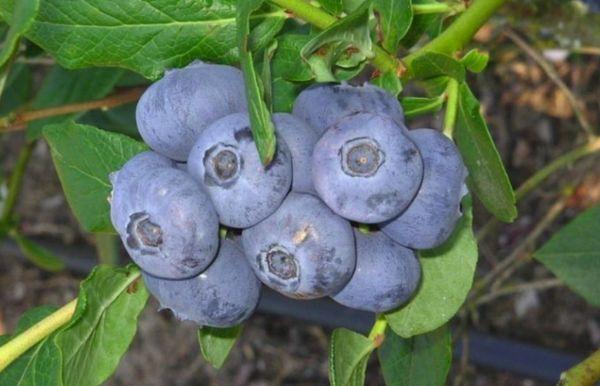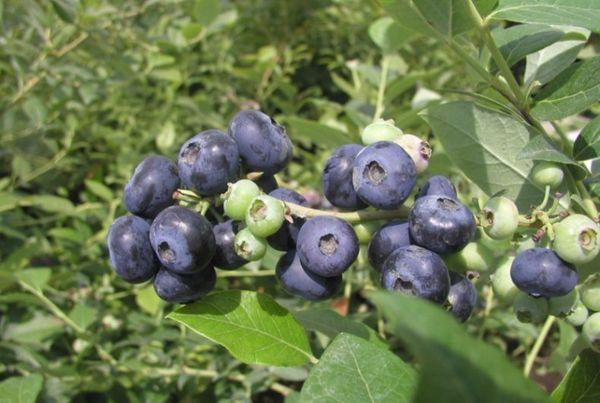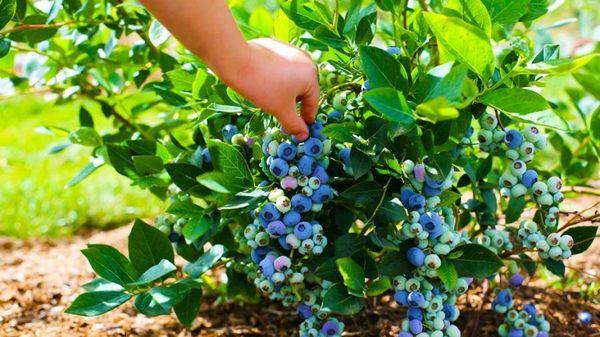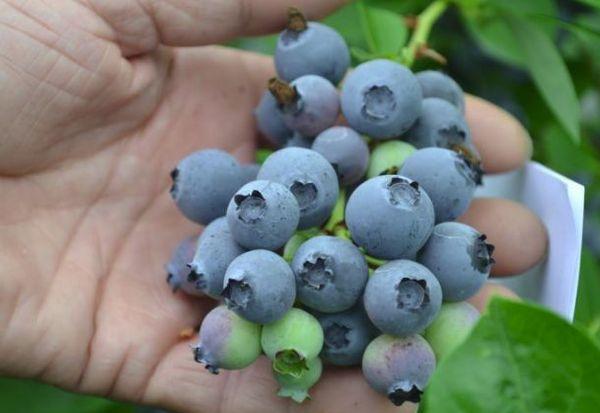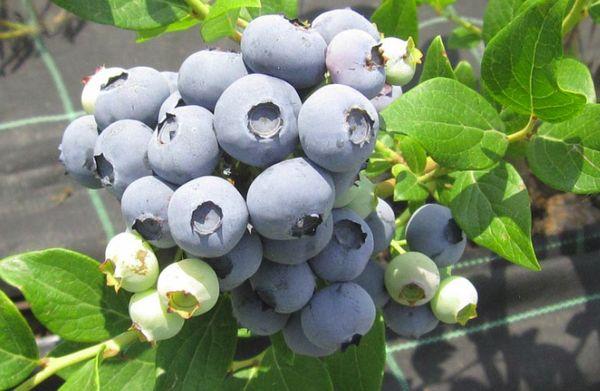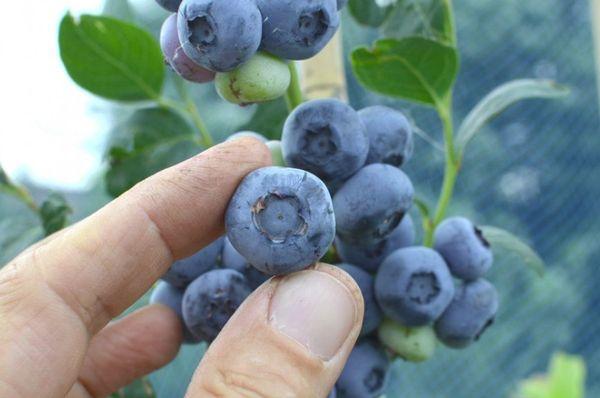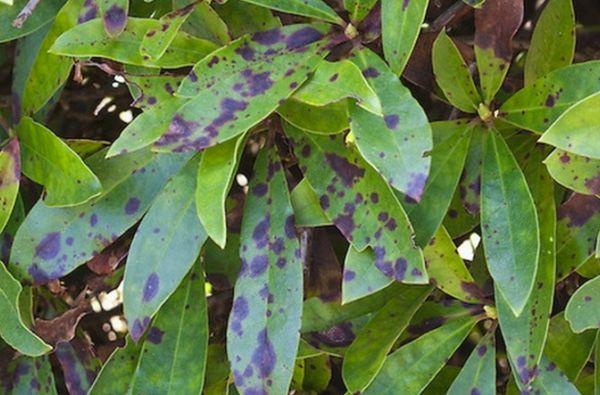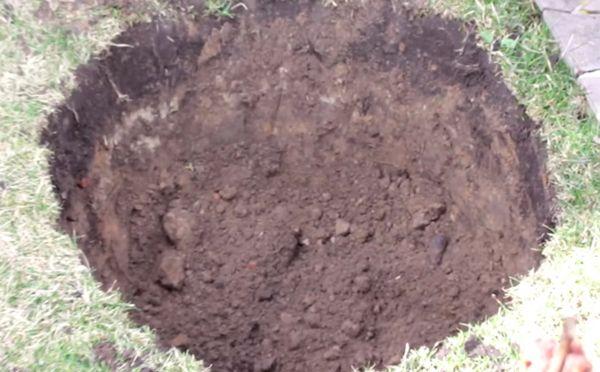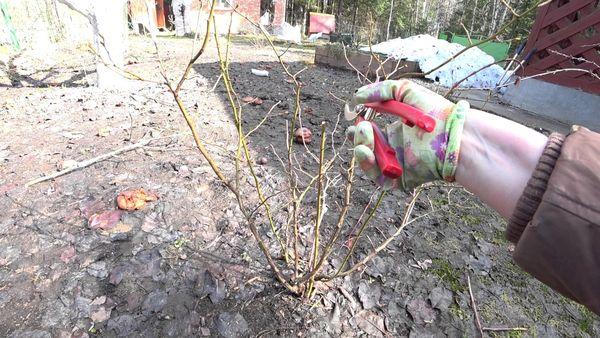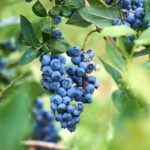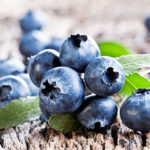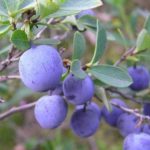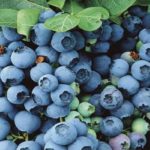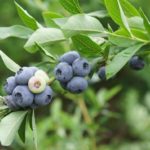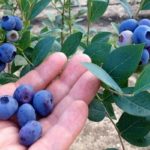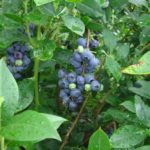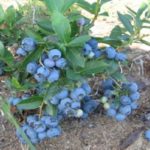Blueberries of the River variety really resemble a river with their color, smooth waves of ripening, and large volumes of juicy berries that contain water. This is one of the modern varieties that quickly gains weight and is characterized by high yield. Gardeners have already appreciated blueberries, and lovers should pay close attention to them, as they are suitable for growing in the central zone of our country.
- The history of the creation of the Blue River variety
- All the advantages and disadvantages of blueberries
- Description and characteristics of varietal blueberries
- Bush and variety of root system
- Blueberry flowering and fruiting
- Collection and use of berries
- Resistance to low temperatures and drought
- Susceptibility to insects and diseases
- How to plant blueberries on the plot
- Suitable timing
- Preparing the planting hole and seedling
- Planting technology
- Rules for caring for crops
- How often to water and feed the River
- Loosening and mulching beds
- Trimming and shaping
- Preventative treatment
- Wintering the plant
- Reviews about the variety
The history of the creation of the Blue River variety
The River variety began its history in New Zealand and was officially registered in 1989, becoming a self-sufficient crop. It has several “parents”: the Reka blueberry was obtained by crossing the Bluecrop, Erliblu, and Ashworth varieties.
The new variety combines the best parental qualities:
- excellent yield;
- excellent quality and taste of the fruit;
- rapid growth and green mass gain.
Reka blueberries are extremely popular in Canada and the USA, and our country is still developing a new variety. It is suitable for farms because it can be harvested mechanically. Private gardens are also adding new plants to their berry collection.
Note: Several New Zealand varieties (Nuru, Puru, Reka) have a license that prohibits their unauthorized reproduction. Gardeners can purchase them under contract, but distribution of the variety is prohibited.
All the advantages and disadvantages of blueberries
The Reka variety is positioned as an early variety: in the southern regions it begins to bear fruit in June, and in mid-latitudes it can be classified as mid-season, since the first harvest occurs at the end of July. A cold spring can delay the harvest by another 2 weeks.
The undoubted advantages of the variety:
- sweet fruits with a slight sour note;
- high tasting taste;
- large and medium size berries;
- their dense consistency;
- strong immunity: adapts well and rarely gets sick;
- decorative appearance;
- high frost resistance (up to -35 C).
River is one of the fastest growing varieties that adapts well to any climate. It is ideal for Russia with its cold winters, continental climate and poor soil.
The disadvantages include:
- periodic pruning;
- long flowering period;
- extended fruiting period;
- high soil requirements;
- fear of drafts and cold winds.
Tip: To maintain the size of the berries, part of the fruit ovaries should be removed from the second year of fruiting. Without this procedure, the harvest will be large, but the berries will be small.
Description and characteristics of varietal blueberries
Blueberries are branched subshrubs, and the Reka variety is tall and reaches 2 m. As it grows, the stem quickly becomes covered with wood and is resistant to lodging.
Bush and variety of root system
The river blueberry bush has the following features:
- volumetric crown size;
- erect skeletal branches;
- branched, numerous shoots;
- rapid growth and formation;
- numerous oblong and shiny leaves up to 3 cm in diameter;
- fibrous root system without root hairs.
The total lifespan of the bush is 100 years; in cultivation it can bear fruit for up to 60 years.
Blueberry flowering and fruiting
Fruiting begins in the 3-4th year, when bell-shaped, white-pink flowers appear on the plant. Racemose inflorescences with 5-toothed, drooping flowers are formed on the branches. Up to 12-20 fruits are formed on one brush. Blueberries are characterized by cross-pollination, so there should be shrubs nearby that bloom at the same time as the “blue grapes.”
The berries ripen in the second half of July and are characterized by:
- dark blue tint with a waxy coating;
- fruit size up to 1.5 cm and weight up to 2 g;
- dense and elastic consistency;
- sweet and sour taste with an admixture of fruity notes;
- pleasant berry aroma;
- good keeping quality and transportability.
The largest harvest wave and the largest fruits are formed with 3-4 harvests per season. The berries stick well to the bushes and do not fall off even in the autumn, when the foliage turns red and flies off. The yield from one bush is 5-10 kg, which depends on climatic conditions and compliance with agricultural practices. In their homeland, blueberries produce up to 10 kg, and in our country - about 5 kg.
Note: The Reka variety is recommended for farms due to the possibility of mechanical harvesting, good shelf life and the ability to transport berries over long distances.
Collection and use of berries
In large plantations, manual harvesting requires human resources. Berry picking is carried out in several stages and labor must be constantly employed. The modern approach is the use of combines.
Units of different brands are produced, but the principle of operation is the same for all: the shaker makes circular movements due to vibration, and the crumbled berries fall into a special hopper. In small garden plots, blueberries are harvested by hand in stages: several times per season, as the berries ripen gradually.
Blueberries are a vitamin and mineral cocktail, so they are best consumed fresh. All kinds of sweet preparations are no less tasty, but not as healthy: jams, jellies, preserves, confitures. The berries are used to make homemade wine. They decorate confectionery products, giving them additional taste.
Resistance to low temperatures and drought
The plant withstands frosty winters and does not need shelter.Young, non-lignified shoots may freeze slightly, but in the spring the bush quickly recovers and gains strength.
Blueberry River is drought tolerant and needs regular watering. A bucket of acidified water is poured under one bush. Overwatering has a bad effect on the root system, which rots.
Susceptibility to insects and diseases
Blueberries of the Reka variety are most affected by fungal diseases in rainy, cool summers. The roots suffer from tracheomycosis wilt. The fungus spreads with planting material; spores persist in the soil and plant debris. Stems and leaves are also susceptible to fungal infections.
Among the pests that visit the plant are:
- triangular leaf roller;
- blue moth;
- yellow peat jaundice;
- heather lancet.
The listed pests include butterflies that damage the plant at the caterpillar stage. Blueberries of the Reka variety rarely get sick and quickly recover from pest damage.
How to plant blueberries on the plot
The correct choice of site, planting time, soil cultivation plays a decisive role in the survival rate and further growth of blueberries. Since the shrub grows in one place for a long time, the characteristics of cultivation are related not only to the climate, but also to the fertility of the soil.
Suitable timing
In the southern regions, the best option would be to plant in the fall. In colder, middle latitudes, it is better to plant bushes in the spring, when the soil warms up. Autumn planting can lead to freezing if the plant does not have time to take root and adapt to new conditions.
Preparing the planting hole and seedling
Planting holes are prepared in advance. Their volume is 60x50 cm. For good survival and growth, use a soil mixture of high-moor peat, sand, sawdust, pine needles with the addition of sulfur (50 g).Blueberry River loves loose, fertile, slightly acidic soils.
It is advisable to purchase a seedling from a specialized nursery. The plant is checked for safety and absence of diseases. A closed root system is preferred. The age of the seedling is 2-3 years.
Planting technology
Planting is carried out according to the following scheme:
- since the bushes are large, the distance between them is 1 m, and in the rows a distance of 3 m is maintained;
- the roots of a seedling without an earthen clod are carefully straightened;
- deepen the root collar by 3 cm;
- the soil around the plant is compacted, watered abundantly, and mulched.
Tip: In order for blueberry bushes to grow evenly and form erect skeletal branches, they are tied together, creating orderly rows of bushes.
Rules for caring for crops
Growing blueberries of the Reka variety does not require a special approach and includes traditional agrotechnical measures. But there are nuances that need to be taken into account when caring for a specific garden crop.
How often to water and feed the River
Blueberries are watered twice a week, in dry periods - twice a day. A bucket of water is used for each bush. Moisture is especially needed during flowering and fruiting, but its excess causes rotting of the roots.
The plant responds well to mineral fertilizing. In the spring, nitrogen supplements are added for the growth of green mass, in the summer - phosphorus-potassium mixtures are applied for better fruiting. One good comprehensive spring feeding is enough to increase productivity. In the fall, the bushes are not fed, otherwise they will not overwinter well.
Tip: Blueberries do not bear fruit in alkaline or neutral soils.When planting and in August, the soil should be shed with a 9% solution of acetic acid, add sulfur, and mulch with pine needles to increase the acidity level.
Loosening and mulching beds
After watering, when the moisture is absorbed into the soil, loosening is carried out to breathe and nourish the roots. The soil is loosened superficially so as not to affect the root system. During processing, the previous layer of mulch is left, updating its composition and quantity. The following is used as mulch:
- chopped straw,
- sawdust;
- pine needles and crushed conifer bark;
- peat.
A layer of mulch protects the soil from weeds and moisture loss, and the roots from overheating or hypothermia.
Trimming and shaping
Reka blueberry bushes need constant pruning. Without it, the branches grow greatly and intertwine, the plant loses part of the harvest and its well-groomed appearance. Pruning is carried out in the spring before the sap begins to flow and before the buds open. The bush is thinned out by removing some of the skeletal branches. Shoots that grow from the roots and spread along the ground are cut off. Of the young shoots, the strongest and most erect ones are left.
Sanitary pruning is carried out during any growing season. Damaged, twisted, diseased branches are cut out. The bushes are thinned out so that the fruiting branches have access to light and air. This way plants are less susceptible to infections.
Preventative treatment
The best way to combat fungal infections is through preventive measures: spraying the bushes with Bordeaux mixture before the leaves bloom, watering the soil under the bush with phytosporin.
If the bushes are attacked by single caterpillar larvae, they are collected manually. In case of massive damage, blueberries are treated with the following drugs: Fufanon, Actellik, Iskra, Inta-Vir.The same agents, but in a lower concentration, are used in spring preventative treatment before flowering begins.
Wintering the plant
Blueberries of the Reka variety are frost-resistant and do not require shelter. If there is little snow in a given region, then supports are created along the bushes, rods are pulled through each bush and the skeletal branches are covered with spruce branches and lutrasil.
Shelter is necessary for bushes planted in the fall that are poorly rooted and have not adapted sufficiently. They are also wrapped in spruce branches, lutrasil, and snow is thrown on top.
Reviews about the variety
Gardeners express conflicting opinions about the variety, although the number of positive reviews is increasing:
Olga, 32 years old, experienced gardener
The River variety bears fruit well. The bushes are large, so it is convenient to pick the berries by hand. The disadvantages include the small size of the berries.
Alina, 45 years old, experienced gardener
The variety is distinguished by the excellent taste of berries, from which I make jam and preserves. The berries are stored in the refrigerator for 2 weeks, so you can eat them fresh. The bushes winter well without shelter.
Andrey, 47 years old, amateur
I’m just learning about a garden crop like blueberries. The River variety was recommended by a neighbor. The harvest is small, but the soil on the site is not fertile enough. The berries make excellent, aromatic wine.
Blueberries of the river variety recently appeared on the Russian market and many gardeners liked them. Long-term fruiting allows you to eat the berries until autumn, and stable yields make it possible to make winter preparations and please your family with tasty and healthy delicacies.

